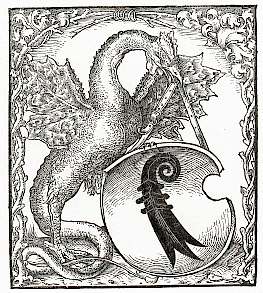The Basilisk
|
The basilisk was considered the most poisonous creature on earth. His appearance was allways a matter of dispute. Early
wood-cuts (e.g., in Ulisse Aldrovandi: Serpentum et Draconu Historiae libri duo. - Bologna, 1640). show an animal with a
domed body, eight legs, a serpent´s tail and a rooster´s head wearing a crown. But allready Athanasius Kircher (Mundus
Subterraneus, Roma, 1678) described his later emanation: the cockatrice. Others considered him a dragon. The antique Romans
called him "regulus" or little king, not only because of his crown, but because he terrorized all other creatures with his deadly
look and poison. His colour was yellow, sometimes with a kind of blackish hue. Plinius mentioned a white spot on his head, which
could be misinterpreted as a diadem or a crown. Others speak of three spikes on his forehead. Most authors agree, that Africa was
his homeland. There he was hatched from the egg of an ibis or a black stork. His manifestation
as cockatrice was rather associated with a rooster´s egg.
|
 |
Regarding his dangerousness three main types were distinguished. The golden basilisk poisoned everything by his mere look.
Another with only a golden head terrorized and killed every creature by his evil eye. A sting of the sanguineous basilisk made the
flesh fall off the bones of his victim. All three had a deadly breath which could even make rocks crumble. The basilisk took his
home in deep wells and rotten cellars or vaults. It is said that mother nature made these creatures seek these remote dwellings
in order to spear both humans and other animals from its deadly look.
 |
In 1587 a basilisk killed three persons in Warszawa (Poland). Playing
hide-and-seek two children - a boy and a girl, both five years old - intended to hide in
an old cellar which had been abandoned for 30 years. When they reached the lowest step
they suddenly fell dead on the floor. They were not found before the evening, when they
were missed by their mothers. A servant was sent out in search. She really found
them, but when she went down into the cellar to waken the apparently sleeping children
she was herself struck by death. However, an old woman had noticed her entering the abandoned
building. She found them all three lying on the ground. All her shouting remained
unanswered. Neighbours came and recovered the corpses with long clasps. The bodies
were swollen, and so were their lips and tongues. Their skin had turned to yellow. From
these signs some learned persons guessed, that a serpent or rather a basilisk had caused
their deaths.
|
A poor sinner was found who had been sentenced to death. He was clad in leather clothes
draped with mirrors. His eyes were protected by strong glasses. With a candle in one hand
and pincers in the other he went down the vault. There after half an hour´s search he found
a strange creature of the size of a cock sitting in a crevasse of the wall. It was at once
killed when it saw its own image reflected by the mirrors. The man took it with the
pincers and brought it up to bright daylight. It was identified as a basilisk with the head
of an indian cock but the eyes of a toad. Its body and wings were coloured with yellow,
blue, red, and green specks. The long, yellow feet were that of a rooster, but its curved
tail resembled that of a snake.
An italian nobleman was killed by a basilisk when he went hunting. For a long time his dog
had barked at a heap of stones when his master tried to find out what embarrassed his dog. He
found a winged serpent. When he tried to slay her, the serpent spread the wings and
blew poisonous breath into his face. At once he fell to the ground and lived just long enough
to tell his companions what he had seen.
Sources
- Happel, E.W. (1683-91): Groesste Denkwuerdigkeiten der Welt oder sogenannte Relationes Curiosae. - Reprint, 554 pp., Berlin (Rütten und Loening), 1990.
- Schlieder, W. (1988): Riesaufdrucke. Volkstümliche Grafik im alten Papiermachergewerbe. - 184 pp., Leipzig (VEB Fachbuchverlag).
- Bock, E. (1922): Die Deutsche Graphik. - 354 p., München (Franz Hanfstaengel).
- Schöpf, H. (1988): Fabeltiere. - 167 pp., Graz (Akademische Verlagsanstalt); Lizenzausgabe 1992 für VMA Verlag, Wiesbaden.
[ Der Basilisk zu Wien (in German) ]
[ Auswahl | Home ]
© MCMXCVIII / MMII by J. Georg Friebe
Erstellt 1998 - aktuelle Version 09.06.2002
|


